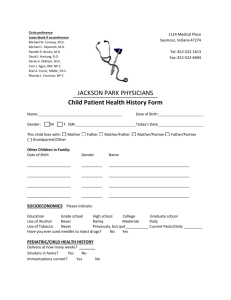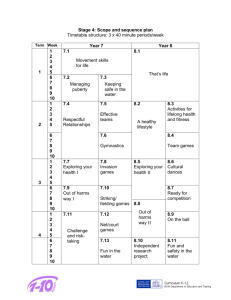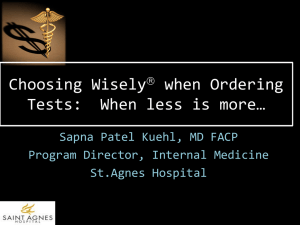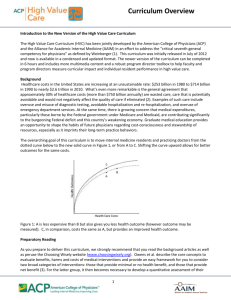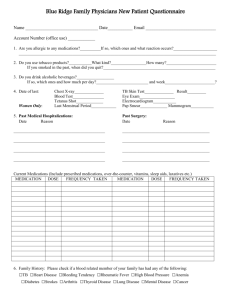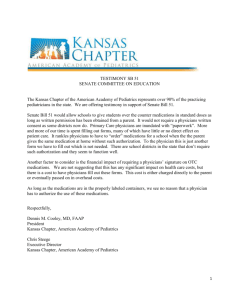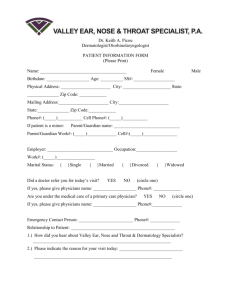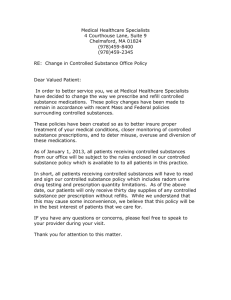Cost Conscious Care - Clinical Departments
advertisement
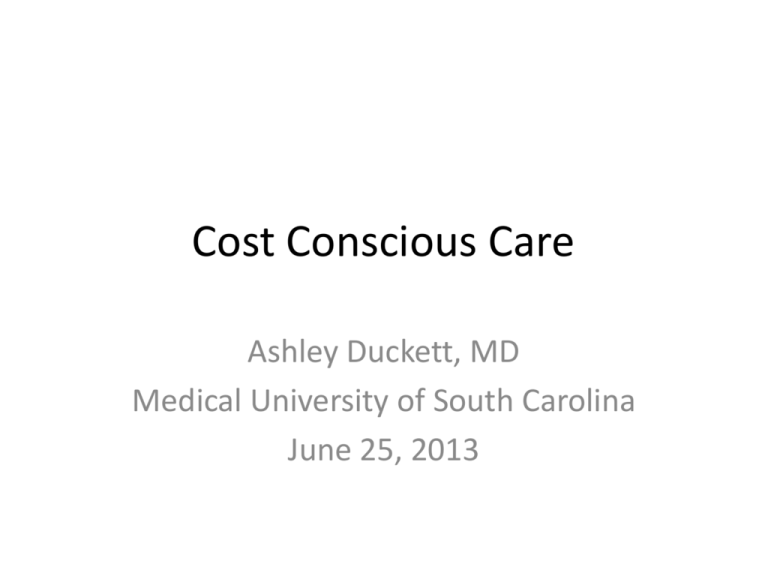
Cost Conscious Care Ashley Duckett, MD Medical University of South Carolina June 25, 2013 Objectives • Understand principles of cost conscious care • Recognize barriers to cost conscious care • Identify available resources for learning about and teaching cost conscious care High Costs of Health Care • Health care is expensive – New tests, drugs, procedures, devices are primary drivers of increased costs – 30% of healthcare costs are wasted costs – 10% of population accounts for 65% of costs • Goal is improved quality, decreased cost – – – – Current system rewards doing more tests Few physicians intentionally abuse system, but all contribute ACOs should align incentives with quality Measuring underuse of high value services (ie preventive services, meds for chronic problems) and overuse of low value services (imaging for low back pain) Costs of Labs • Physicians have poor understanding of costs – Costs include downstream costs of unintended consequences – Estimates online at http://healthcarebluebook.com/ or http://clearhealthcosts.com/ • Cost is not the same as value – Low cost interventions may have little value and high cost interventions may have good value • Least experienced physicians have most control over ordering of lab tests in inpatient setting • Little understanding of comparative utilization and practice patterns – Residents need to get feedback on their ordering patterns, particularly in comparison to others on the same service Reporting Milestones www.im.org Cost-Effectiveness of Selected Preventive Measures and Treatments Intervention H flu vaccination of toddlers One time colonoscopy screening for CA in men 60-64 Screening all 65 y/o for DM (compared with those with HTN) HAART for HIV Defibrillators Cost-Effectiveness Ratio Cost-saving Cost-saving $590,000/ QALY $29,000/QALY $52,000/QALY Cost effectiveness= Incremental costs / Incremental health benefits (in terms of QALY’s), relative to a comparator (no treatment or current treatment). Cost effectiveness threshold of $50,000-$100,000 per QALY has historically been considered acceptable QALYs are not used at the direct patient care level, but may help understand the balance between benefits, risks/harms, and costs associated with medical interventions Cohen J, Neumann P, Weinstein M NEJM 2008:358;7 Choosing Wisely • ABIM campaign to spark dialogue about waste in healthcare system – Promote care that is necessary, free from harm, not duplicative and supported by evidence • 5 things Physicians and Patients Should Question • Patient friendly resources from Consumer Reports – Chronic Kidney Disease: Making Hard Choices – Cancer Care at the End of Life: When to Choose Supportive Care Choosing Wisely – SHM Adult Hospitalist “Avoid List” 1. No foley catheters for convenience, incontinence or monitoring uop 2. No stress ulcer prophylaxis unless high risk 3. No blood transfusions in absence of symptoms (or active ACS, CHF, or stroke) 4. No telemetry outside of ICU without a protocol 5. No repeat CBC, BMP in setting of lab stability Choosing Wisely – ACP “Avoid list” 1. No screening exercise electrocardiogram testing in individuals who are asymptomatic and at low risk (<10% 10 year risk) for coronary heart disease. 2. No imaging studies in patients with non-specific low back pain. 3. In the evaluation of simple syncope and a normal neurological examination, don’t obtain brain imaging studies (CT or MRI). 4. In patients with low risk for VTE order D-dimer instead of imaging as first test. 5. No preoperative chest radiography in the absence of a clinical suspicion for intrathoracic pathology. Choosing Wisely – American Geriatrics Society “Avoid List” 1. Don’t recommend PEG tubes in patients with advanced dementia; instead offer oral assisted feeding. 2. Don’t use antipsychotics as first choice to treat behavioral and psychological symptoms of dementia. 3. Avoid using medications to achieve hemoglobin A1c <7.5% in most adults age 65 and older; moderate control is generally better. 4. Don’t use benzodiazepines or other sedative-hypnotics in older adults as first choice for insomnia, agitation or delirium. 5. Don’t use antimicrobials to treat bacteriuria in older adults unless specific urinary tract symptoms are present. ACP/AAIM Curriculum • 10 modules, PP presentations, facilitators guides 1. Introduction to Healthcare Value 2. Healthcare Waste, Costs, and Over-Ordering of Tests 3. Health Insurance 4. Healthcare Costs and Payment Models 5. Biostatistical Concepts You Need to Know 6. Screening and Prevention 7. Balancing Benefits with Harms and Costs 8. High Value Medication Prescribing 9. Barriers to High Value, Cost Conscious Care 10. Local QI Project Steps Toward High-Value CostConscious Care Step 1: Understand the benefits, harms, and relative costs of the interventions that you are considering Step 2: Decrease or eliminate the use of interventions that provide no benefits and/or may be harmful Step 3: Choose interventions and care settings that maximize benefits, minimize harms, and reduce costs (using comparative effectiveness and cost-effectiveness data) Step 4: Customize a care plan with the patient that incorporates their values and addresses their concerns Step 5: Identify system level opportunities to improve outcomes, minimize harms, and reduce healthcare waste ACP website Reasons Residents Over Order Tests 1. Duplicating role modeled behavior 2. Desire to be complete 3. Pre-emptive ordering/rushing an evaluation/unnecessary duplication of tests 4. Discomfort with Diagnostic Uncertainty 5. Curiosity 6. Lack of knowledge of the costs and harms 7. Defensive medicine 8. Patient requests 9. Faculty demand 10. No training in weighing benefit relative to cost and harm 11. Ease of access to services when patient is hospitalized Questions to ask before ordering tests • Did the patient have this test previously? • Will the result of this test change the care of the patient? • What are the probability and potential adverse consequences of a false positive result? • Is the patient in potential danger in the short term if I do not perform this test? • Am I ordering the test primarily because the patient wants it or to reassure the patient? Stats You Can Use • Likelihood ratios – How to use a test to change your confidence – Calculated from sensitivity and specificity – Can be applied to physical exam findings as well as lab tests and imaging • Pretest probability • Odds ratios (case-control), relative risks (RCTs and cohort studies) • Relative Risk Reduction, Absolute Risk Reduction, number needed to treat (NNT) and number needed to hard (NNH) Role of History and Physical Exam • History and physical exam are very cost-conscious and can be high value – Inpt and outpt studies show most dx made on H&P alone • Physicians lack confidence in physical exam • Undervalue physical exam, especially negative findings – In the presence of important physical findings (those with high LR’s) we order more tests, even though there is a high probability of a disease being present – With negative clinically relevant physical exam findings we are even more likely to order extra tests • Need to understand clinical utility of history and physical exam findings and apply to patient care – Rational Clinical Exam series in JAMA, lit searches High Value Medication Use 1. Is prescription medication absolutely necessary? Know when drugs are indicated. Stop any medications that are not indicated. Don’t be afraid to try lifestyle modifications or over the counter medications in lieu of prescriptions. 2. Which medications should I prescribe? For insured patients, try to find equivalent medications on their formularies. “CR” and “ER” preparations and combo drugs tend to be more expensive. 3. Should I use generic vs. brand name? MOST (not all) drugs can be safely switched to generics. Generics are 1/4 to 1/10 of the cost. • Evaluate affordability before prescribing new medications to patients Defensive Medicine • • • • Very common barrier to cost-effective care Leads to overutilization Doesn’t protect against malpractice Malpractice claims can be arbitrary and hard to prevent: 40% do not involve medical errors • More care is not better care -- tests and treatments have harms associated with them • Lack of follow up of abnormal test results often leads to malpractice litigation- don’t order the test if you don’t plan on following it up and acting on the results • Tips: listen to your patients and carefully document decision making including discussion of side effects and risks of all tests and treatments Key Messages • Be aware of tests and treatments that are not considered to be high value or cost conscious • Consider costs and value when ordering new medications and diagnostic testing References Baker et al. Design and Use of Performance Measures to Decrease Low-Value Services and Achieve Cost-Conscious Care. Ann Intern Med. 2013;158(1):5559. Dine et al. Educating Physicians in Training About Resource Utilization and Their Own Outcomes of Care in the Inpatient Setting. Journal of GME. 2010; 2(2); 175-80. Herrle et al. Bayes Theorem and the Physical Examination: Probability Assessment and Diagnostic Decision Making. Academic Medicine. 2011; 86 (5): 618-27. Qaseem et al. Appropriate Use of Screening and Diagnostic Tests to Foster High-Value, Cost-Conscious Care. Ann Int Med. 2012; 156 (2): 147-49. choosingwisely.org hvc.acponline.org
